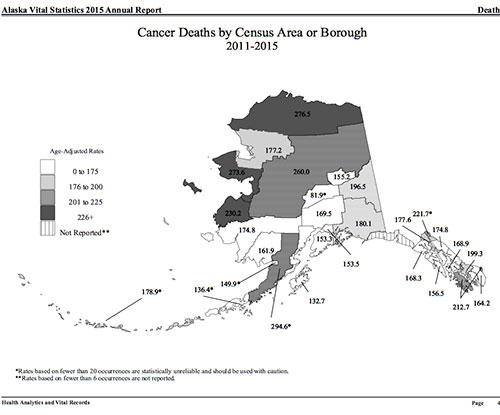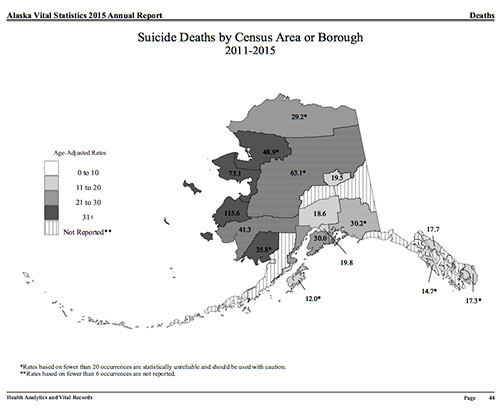
Alaska Vital Statistics Annual Report Released
January 26, 2017
In 2015, Alaskan mothers gave birth to 11,291 babies, resulting in a slightly increased fertility rate of 77 births per 1,000 women of childbearing age since 2006. In 2015, 5,478 marriages were performed and there were 1,590 divorces; both rates declining over the last decade. In total, 4,324 deaths occurred among Alaskan residents. Cancer Deaths in Alaska by Area The top 10 leading causes of death accounted for 73 percent of all deaths in Alaska. Ranked in order they are: 01. Cancer Age-adjusted rates of cancer and stroke have decreased over the past 10 years according to the 2015 Alaska Vital Statistics Annual Report. Among factors that may be contributing to these declines are cancer screening and decreased use of tobacco products. The Alaska Department of Health and Social Services wrote in a news release that tobacco use is the leading cause of preventable deaths and is associated with several types of cancer and stroke. The 2015 Alaska Vital Statistics Annual Report also highlights some additional categories of death: drug-induced deaths, which includes drug overdoses, and firearm related deaths. Opioid overdoses accounted for 71 percent of drug-induced deaths in 2015. Also in 2015, 69 percent of all firearm deaths in Alaska were suicides. Alaska Suicide Deaths by Area Data and health indicators presented in the Alaska Vital Statistics Annual Report are based upon information supplied by many people throughout the state. Birth mothers, doctors, midwives, other birth attendants, medical facilities, medical examiners, magistrates, funeral directors, and a host of other individuals complete information on vital records. However, according to a 2016 study by John Hopkins Medicine, medical errors are now the third leading cause of death in the U.S. The question would be why are medical errors not reported in the vital statistics? According to the Johns Hopkins team, the U.S. Center for Disease Control’s way of collecting national health statistics fails to classify medical errors separately on the death certificate. Johns Hopkins patient safety experts have calculated that more than 250,000 deaths per year are due to medical error in the U.S. Their figure, published May 3, 2016, in The BMJ, surpasses the U.S. Centers for Disease Control and Prevention’s (CDC’s) third leading cause of death — respiratory disease, which kills close to 150,000 people per year. The BMJ is a weekly peer-reviewed medical journal. It is one of the world's oldest general medical journals. The BMJ was originally called the British Medical Journal. The title was officially shortened to BMJ in 1988, and then changed to The BMJ in 2014. “Incidence rates for deaths directly attributable to medical care gone awry haven’t been recognized in any standardized method for collecting national statistics,” says Martin Makary, M.D., M.P.H., professor of surgery at the Johns Hopkins University School of Medicine and an authority on health reform. “The medical coding system was designed to maximize billing for physician services, not to collect national health statistics, as it is currently being used.” In 1949, Makary says, the U.S. adopted an international form that used International Classification of Diseases (ICD) billing codes to tally causes of death. “At that time, it was under-recognized that diagnostic errors, medical mistakes and the absence of safety nets could result in someone’s death, and because of that, medical errors were unintentionally excluded from national health statistics,” says Makary. The researchers say that since that time, national mortality statistics have been tabulated using billing codes, which don’t have a built-in way to recognize incidence rates of mortality due to medical care gone wrong. The John Hopkins researchers are advocating for updated criteria for classifying deaths on death certificates Using hospital admission rates from 2013, the John Hopkins researchers extrapolated that based on a total of 35,416,020 hospitalizations in the United States, 251,454 deaths stemmed from a medical error, which the researchers say now translates to 9.5 percent of all deaths each year in the U.S. According to the U.S. Center for Disease Control, in 2013, 611,105 people died of heart disease, 584,881 died of cancer and 149,205 died of chronic respiratory disease — the top three causes of death in the U.S. The newly calculated figure for medical errors puts this cause of death behind cancer but ahead of respiratory disease. “Top-ranked causes of death as reported by the CDC inform our country’s research funding and public health priorities,” says Makary. “Right now, cancer and heart disease get a ton of attention, but since medical errors don’t appear on the list, the problem doesn’t get the funding and attention it deserves.” The John Hopkins researchers cautioned that most of medical errors aren’t due to inherently bad doctors, and that reporting these errors shouldn’t be addressed by punishment or legal action. Rather, they say, most errors represent systemic problems, including poorly coordinated care, fragmented insurance networks, the absence or underuse of safety nets, and other protocols, in addition to unwarranted variation in physician practice patterns that lack accountability. “Unwarranted variation is endemic in health care. Developing consensus protocols that streamline the delivery of medicine and reduce variability can improve quality and lower costs in health care. More research on preventing medical errors from occurring is needed to address the problem,” says Makary. According to the 2015 Alaska Vital Statistics Annual Report, the Alaska median female age at death was 72, the median male age at death was 66, with the median age statewide at 68 years old. Average life expectancy reported by the CDC nationwide is 78.8 years. Although life expectancy for the total population remained unchanged since 2012, life expectancy for non-Hispanic white females decreased from 2013 to 2014. The median age at death of white people in Alaska was 70 years, while the median age at death of American Indian/Alaska Native people was 61 years. Nationwide, the Center for Disease Control lists the 15 leading causes of death as: 01.Diseases of heart (heart disease)
On the Web:
Reporting & Editing by Mary Kauffman, SitNews
Source of News:
Representations of fact and opinions in comments posted are solely those of the individual posters and do not represent the opinions of Sitnews.
|
||

